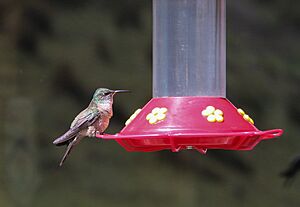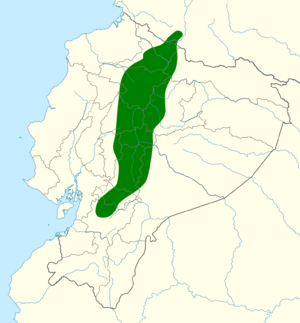Ecuadorian hillstar facts for kids
Quick facts for kids Ecuadorian hillstar |
|
|---|---|
 |
|
| Male on Chuquiraga sp. | |
 |
|
| Female in Cotopaxi National Park | |
| Conservation status | |
| Scientific classification | |
| Genus: |
Oreotrochilus
|
| Species: |
chimborazo
|
 |
|
| Distribution (green) in Ecuador and South America | |
The Ecuadorian hillstar (Oreotrochilus chimborazo) is a special type of hummingbird. It is also known as the Chimborazo hillstar. This bird lives in the Andes mountains. You can find it in Ecuador and the very southern part of Colombia. It prefers high-up mountain grassland areas. These areas are usually between 3,500 and 5,200 meters high.
Contents
Meet the Ecuadorian Hillstar
The Ecuadorian hillstar is about 12 cm long. It weighs around 8 grams, which is like a couple of paper clips. It has a black beak that is slightly curved downwards. This beak is about 2 cm long.
What They Look Like
Male hillstars are very colorful. They have a bright, shiny violet-purple head. Below their head, there is a black stripe across their chest. Their back is a dark olive green. Their belly is white with a dark line down the middle. The feathers in the center of their tail are blue-green. The other tail feathers are mostly white with black tips and edges.
Female hillstars are not as bright. Their back is a duller olive green. Their throat is whitish with small brown spots. Their tail is dark. The rest of their underside is a pale grayish color.
Different Types of Hillstars
There are two main types, or subspecies, of the Ecuadorian hillstar. You can tell the males apart by looking at their throats.
- The O. c. jamesonii subspecies has a completely shiny violet-purple throat.
- The O. c. chimborazo subspecies has a violet-purple upper throat. It also has a shiny aquamarine patch on its lower throat.
Both types have the black chest stripe below their throat.
Where They Live
The O. c. chimborazo subspecies lives around the Chimborazo and Quilotoa volcanoes. It also lives in the grasslands between them. The O. c. jamesonii subspecies is found in more places. It lives in suitable habitats from southern Colombia. It also lives in the mountains of Azuay Province in Ecuador. You can often find it near volcanoes like Cotacachi, Pichincha, Antisana, Iliniza, and Cotopaxi.
There was once a third subspecies, O. c. soderstromi. It was thought to live only near the Quilotoa volcano. However, this subspecies has not been seen since it was first described. Scientists think it might just be a mix of the other two types. Both O. c. chimborazo and O. c. jamesonii have been seen where O. c. soderstromi was supposedly found. So, this third subspecies might not be a real, separate type.
Life in the Mountains: Food and Home
Nectar is a very important food for the Ecuadorian hillstar. They mostly get it from the orange flowers of the Chuquiraga shrub. Unlike many hummingbirds, they often land on plants to feed. They do not always hover in the air. This helps them save energy in their cold mountain home.
Insects are also an important food source. They catch many insects in the air. They also find them in plants and along cliffs. At night or when the weather is bad, they find shelter. They hide in caves or cracks in rocky areas. To save energy during the night, they go into a deep sleep called torpor.
Building a Nest
Ecuadorian hillstars build their nests in safe places. They often choose caves or steep rock walls. These spots usually have an overhang. This protects the nest from hail, rain, and strong midday sun. Some nests are built in thick bushes for protection.
Their nests are quite large for a hummingbird. They build them using warm materials. These include grass, moss, feathers, and plant fluff. They even use horse hair and rabbit fur. If a spot is very good for nesting, you might find several nests close together. A female hillstar usually lays two eggs. The male does not help build the nest. He also does not help hatch the eggs or feed the young birds.
Why They Are Special to Scientists
The Ecuadorian hillstar has two different subspecies. This is interesting because they live in a small area. Many famous biologists, like Alfred Russel Wallace, have studied this. Wallace wrote that these birds have some of the smallest living areas of any bird.
Scientists believe the different types are due to the Andes mountains. The mountains have a complex shape. This might have separated groups of birds long ago. This separation could have led to the different subspecies. Even though there are no clear barriers now, past climate changes might have caused this. These changes happened during the Ice Age. The differences between the subspecies are not very big in their DNA. This suggests the separation might not have happened too long ago.


